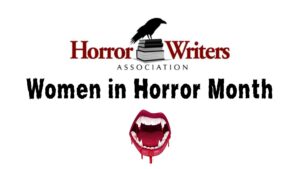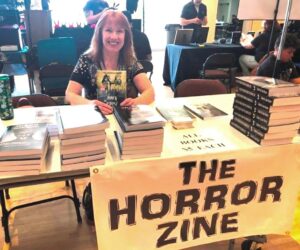Women in Horror Month 2024: An Interview with Jeani Rector

What inspired you to start writing?
In fifth grade, I loved both art and writing. My teacher told my mother, “Encourage her writing over her art.” Which meant I was no good at art, LOL. Also, fifth grade was when I began devouring books. But it wasn’t until I read Stephen King’s Salem’s Lot that I began to focus on the horror genre.
I would be willing to bet that most writers today began loving the craft as far back as elementary school. Once they began writing in earnest, it became almost compulsive. Most writers today feel a “need” to write. They are naturally talented, but the “need” establishes a discipline within them. That discipline combined with talent creates a synergy to produce a product that is greater than the sum of their separate efforts.
What was it about the horror genre that drew you to it?
I am attracted to horror books and films because it is similar to riding a roller-coaster: you get excitement and thrills, yet you know deep down that you will land safely because it is all pretend. Horror is fun without consequences. There is something visceral and ingrained in people to seek out the morbidly fascinating. Reading a horror story or watching a film often makes us more appreciative of our own calm existence after vicariously experiencing a protagonist’s fears. Probably the best thing about the horror genre is that it is suspenseful. There are almost always confrontation scenes, chase scenes, monster revelation scenes, and victims that may or may not escape. Horror is unpredictable and often contains surprising twists.
Do you make a conscious effort to include female characters and themes in your writing and if so, what do you want to portray?
When writing a short story, it is important to remember to use logic: things must make sense. Readers are sophisticated and they don’t like plot holes or things occurring out of the blue for no logical reason. This is especially true for female characters. Gone are the days when women in horror were bubble-headed victims. Today’s horror recognizes women as intelligent people who fight back and not just faint like the old (unrealistic) days. Many readers (including me) don’t like to see female characters making unbelievable, irrational decisions and/or doing stupid behaviors right out of a bad teenage horror movie. People tend to root for intelligent, action-oriented women who do their best in a bad situation. Here is how to avoid making unnecessary mistakes when writing: always put yourself into your character’s shoes. What would you do if you were your character? How would you behave in their situation? How would you react? And the most important of all: how would you feel? This humanizes your character and makes them more real. Showing emotions adds to the suspense. Many times when writers try to write as the opposite gender, they try to imagine what it would be like to be that gender. Sometimes that attempt falls into stereotypes. I think the way to avoid stereotypes if you want to write as an opposite gender (or as someone with a different sexuality than yours) is to picture someone you know well and model your character after that friend. Or to have someone else edit your work. I once wrote a story as a male character and The Horror Zine’s Assistant Editor, Dean H. Wild, went over the story and suggested changes. The result was a more genuine male character instead of me trying to sound male.
What has writing horror taught you about the world and yourself?
Unexpected things do happen in life. Horror is basically writing about unexpected things.
How have you seen the horror genre change over the years? And how do you think it will continue to evolve?
In the 19th Century, horror mostly involved creatures like vampires and Frankenstein’s monster and werewolves. In 1959, Shirley Jackson’s novel The Haunting of Hill House made the paranormal popular. In 1973, the film The Exorcist opened the door to Satan and the fight between good and evil. When the movie Halloween came out in 1978, it created the slasher genre. My point is: that horror is always evolving.
How do you feel women have been represented thus far in the genre and what hopes do you have for representation in the genre going forward?
Women have come a long, long way in the horror genre. Today they are recognized as important protagonists instead of the useless eye candy of yesteryear. Remember the B-movies of the 1950s that always portrayed women as helpless yet sexualized females with their shirts always torn to reveal a busty figure? Today’s women in horror participate in the action and are not just empty visual stimulation.
Who are some of your favorite female characters in horror?
Oh, what a good question! My very favorite is Jamie Lee Curtis’ character Laurie in Halloween! What a great portrayal of a courageous woman who cleverly outsmarts a truly frightening monster! And then there is Sigourney Weaver in Alien. Her character doesn’t break even when the alien is “in her face” salivating. In books, Mexican Gothic by Silvia Moreno-Garcia is a good one. Many novels by Grady Hendrix portray strong female characters. Mine by Robert McCammon is an interesting book because both the heroine and villain are female.
Who are some women who write horror that you recommend our audience check out?
I am currently reading Experimental Film by Gemma Files and loving it. Works by Sarah Pinborough, Susie Moloney, and Elizabeth Massie are always top-notch. Novels by Alma Katsu, Nancy A. Collins, Lucy A. Snyder, S.P. Miskowski, Darcy Coates, and Kathy Ptacek are always exciting. Let’s not forget horror poetry. Works by Ashley Davis, Stephanie M. Wytovich, and Stephanie Smith is hauntingly unsettling. There are so many great Women in Horror—too many to mention here. Check out the March issue of The Horror Zine for a more complete list of Women in Horror on the Home Page.
What is one piece of advice you would give horror authors today?
Joe R. Lansdale once told me that to write fiction, you need to read fiction. Read a lot of fiction! Learn about style and substance from the best writers. I know you only asked for one thing, but I will take the liberty to add: Whatever you do, never start a story with boring explanations and details. Make your first three paragraphs lively and interesting. You can weave the explanations into the body of the story, but even then, be prudent. Give the reader credit for figuring out some things on their own. Don’t bore your reader or they could go elsewhere. I am sure you have heard of “telling” the story versus “showing” the story. Telling the story is a passive voice; it can be likened to a newspaper article: just the facts, ma’am. Showing the story is to reveal events as they occur, in real time. It is to show feelings and reactions, again as they occur. Feelings are more important than a lot of new writers realize.
And to the women who write horror out there who are just getting started, what advice would you give them?
1) Start with action
2) Familiarize the reader with your protagonist; make them likable
3) Provide an obstacle for your character
4) Describe how your character overcomes, or at least deals with, the obstacle
5) Perhaps you might want to provide an exciting chase scene; it’s not absolutely necessary but could add some thrills
6) Give your reader hints as to the ending
7) Provide a completely different ending than your hints—hence the twist
An obstacle is vital to your story; it is most likely the centerpiece of the story. An obstacle creates a challenge for your character and inserts the reader into a “make or break” situation. It is also the place where your reader roots for your character if they are nice, and it is the place where the reader hopes for failure if your character is evil. You have always heard praise for the finest stories as having “an unexpected twist” at the end. Be the writer who earns that praise!
 While most people go to Disneyland in Southern California, Jeani Rector went to the Fangoria Weekend of Horror instead. She grew up watching the Bob Wilkins Creature Feature on television and lived in a house that had the walls covered with framed Universal Monsters posters. It is all in good fun and actually, most people who know Jeani personally are of the opinion that she is a very normal person. She just writes abnormal stories.
While most people go to Disneyland in Southern California, Jeani Rector went to the Fangoria Weekend of Horror instead. She grew up watching the Bob Wilkins Creature Feature on television and lived in a house that had the walls covered with framed Universal Monsters posters. It is all in good fun and actually, most people who know Jeani personally are of the opinion that she is a very normal person. She just writes abnormal stories.
Jeani Rector is the founder and editor of The Horror Zine and has had her stories featured in magazines such as Aphelion, Midnight Street, Strange Weird and Wonderful, Dark River Press, Macabre Cadaver, Blood Moon Rising, Morbid Outlook, Horror in Words, Black Petals, Bewildering Stories and others.



